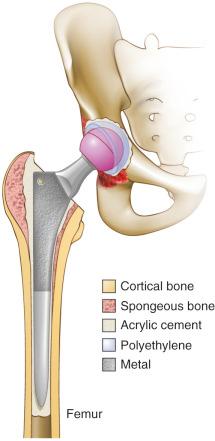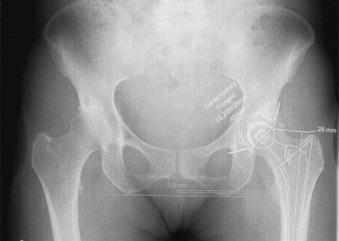Physical Address
304 North Cardinal St.
Dorchester Center, MA 02124
Cemented total hip replacement (THR) continues to be a commonly performed technique in arthroplasty.
The cemented acetabular component is often considered the “weak link” in the longevity of a fully cemented THR.
Each patient should undergo assessment and plain radiographic examination to ensure accurate templating and planning of the operation.
Best practice in performing the technique of cementing the component is described.
Limitations of the procedure are explained.
Results of the procedure are discussed.
Total hip replacement (THR) remains an excellent operation in alleviating pain and improving function and quality of life from osteoarthritis (OA). The modern hip replacement evolved from the first successful “low-friction arthroplasty” by John Charnley. This employed a fully cemented design, including a polyethylene acetabular component using dental cement.
A cemented acetabular replacement is a composite of materials with different moduli of elasticity compared with bone. Cement, which acts as a grout between the articulating component and the bone, allows torque forces produced at the articulation to be transmitted to the bone to minimize the shear stress effect on the bone ( Fig. 63.1 ).

Materials and techniques have improved over the 50 years that have passed since the development of low-friction arthroplasty, including the use of highly cross-linked polyethylene (HXLPE) and various specialized bone cements. Techniques—including pulsed irrigation, drilling, and pressurization—are discussed further in a dedicated section.
Despite these advances, the use of cemented acetabular components has declined and are now rarely implanted in the United States. This is likely due to intermediary results with cup loosening and the labeling of cemented components as the weak link in THR. However, from an evidence-based perspective, cemented polyethylene cups remain a successful and cost-effective option in THR. Recent randomized trials compiled into systematic reviews also outline the lack of evidence of any significant difference between cemented and uncemented components.
Indications for using a cemented acetabular component when performing a THR are controversial. However, given the long period during which cemented acetabular components have been used, there is data to support implantation in most patients. Particularly successful patient groups include those with osteopenia or metabolic bone disease, previous pelvis irradiation, and the elderly population (> 65 years old).
Cemented fixation of the acetabulum remains the most commonly used THR method in certain regions of Europe. The cemented all-polyethylene component is much cheaper to insert and its use in experienced hands produces excellent long-term results. Exclusions for the cemented method include the following:
Excessive bleeding following reaming
Extensive cyst formation
Inflammatory arthropathies
Advanced dysplasia (Crowe III/IV)
Protrusio deformities
Significant cardiopulmonary disease
These indications/exclusions are by no means exhaustive but when used can produce excellent results. In addition to ensuring appropriate patient selection, the selection of the specific cemented acetabular implant should be made based on literature, published results, and the surgeon's familiarity with the component. Various studies of cemented acetabular components are summarized in Table 63.1 .
| Author/Date | Prosthesis | No. of Hips | Minimum F/U, y | Revision Rate, % |
|---|---|---|---|---|
| Delee and Charnley/1976 | Charnley | 141 | 10 | NR |
| Ritter et al./1990 | Charnley | 238 | 10 | 4.6 |
| Wroblewski and Siney/1993 | Charnley | 193 | 18 | 3 |
| Kavanagh et al./1994 | Charnley | 112 | 20 | 16 |
| Callaghan et al./2004 | Charnley | 27 | 30 | 12 |
| de Jong et al./2009 | Weber | 117 | 10 | 1 |
| de Jong et al./2009 | Weber | 117 | 20 | 14 |
| Vietch et al./2010 | Exeter | 263 | 15 | 11 |
| Agandi et al./2012 | Ultima | 287 | 10 | 9 |
| Aubault et al./2013 | Zimmer | 83 | 12 | 2 |
Among the potential advantages of cemented acetabular components, avoidance of acetabular fracture is important. Patients with osteoporotic bone, which may not be appreciated on preoperative radiographs, are at increased risk of this complication with uncemented cups. Similarly, iliopsoas irritation from retroverted or overhanging uncemented cups is a problem avoided with the cemented option. Finally, the stress-shielding phenomenon has been described in association with uncemented implants. This problem seems to be avoided with cemented cups because stresses are distributed over a wider area compared with the very stiff implants used in uncemented cups, which concentrate the stresses.
However, the use of cemented cups is currently limited to polyethylene rather than modern bearing surfaces. The use of cross-linked ultra-high-molecular-weight polyethylene (UHMWPE) has demonstrated a significant reduction in wear.
Preoperative planning is an essential part of THR surgery. The critical aspects of preoperative planning include the following:
Ensuring that appropriate implants are obtained prior to surgery
Ensuring that correct sizes are available
Providing knowledge of the anatomic challenges of each individual hip
Restoring appropriate biomechanics
Avoiding leg length inequalities
Reducing intraoperative complications
Each patient must undergo plain radiographic examination for accurate planning of the operation. An anteroposterior (AP) pelvic view with the extremities internally rotated 15 degrees that includes the proximal third of the femur and a lateral view of the affected hip should be routine. The basic principle is to restore normal hip anatomy and, subsequently, reestablish normal hip biomechanics. Modern templating is often performed on digital radiographs using commercially available templating programs. Therefore, it is imperative to obtain accurate scaling of the radiographic view. This requires the use of a templating ball of known dimension with every radiograph taken for arthroplasty surgery.
Accurate templating improves with experience; however, certain conventions, when followed, enhance the accuracy of acetabular templating. Positioning of the acetabular component predicts the center of rotation of the replaced joint; therefore, it is an essential step in the process. One of the main objectives is to provide sufficient support for the acetabular component within the native socket. The radiologic “teardrop” is an important reference point, indicating the acetabular floor. The lateral lip of the teardrop corresponds to the outer acetabular floor and the medial lip corresponds to the inner floor. The template should not be placed medial to this anatomically consistent point. The abduction angle should be 40 to 45 degrees. A 2-mm allowance for the bone cement should be taken into consideration when the size and position of the acetabular component are assessed ( Fig. 63.2 ).

If complex anatomic deformities are noted or if the socket is very deficient, a computed tomography (CT) scan is often helpful.
The key technique stages that are associated with successful implantation (reduced lucency and early loosening) are summarized by Crites et al. These include the following:
Reaming to the cancellous acetabular bed with penetration and removal of the sclerotic area from zone 1
Jet pulsatile lavage irrigation of the cancellous bone and any drill holes
Meticulous drying of the acetabulum, including use of thrombin or a vasoactive agent
Complete coverage of the component within the bony acetabulum
Pressurization of the entire acetabulum at the same time
The approach used to access the hip joint when cementing the acetabular component should provide complete exposure. This includes visualization of the transverse acetabular ligament (TAL), which is used as a landmark of anteversion. There are a variety of surgical approaches that can be used for THR; it is not within scope of this chapter to recommend any particular method. The senior author's unit employs the posterior hip approach. It is important to caution against the use of minimally invasive techniques unless they provide the required exposure. Capsular release may be required for adequate femoral retraction to enable visualization. During exposure, osteophytes obscuring the TAL must be removed and the labrum and extraneous soft tissue should be excised to expose the edge of the acetabulum.
Become a Clinical Tree membership for Full access and enjoy Unlimited articles
If you are a member. Log in here